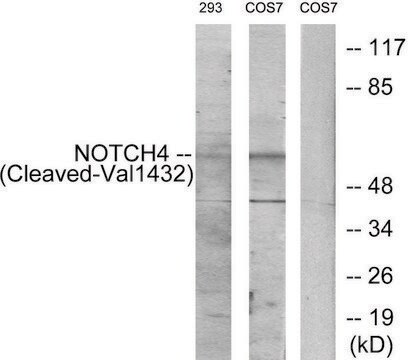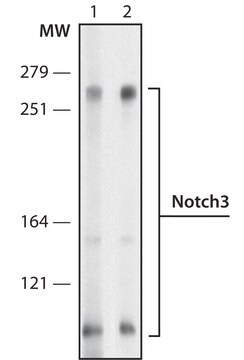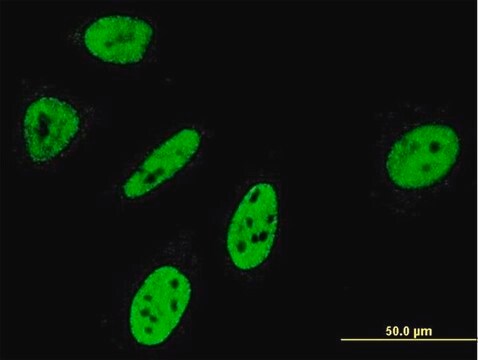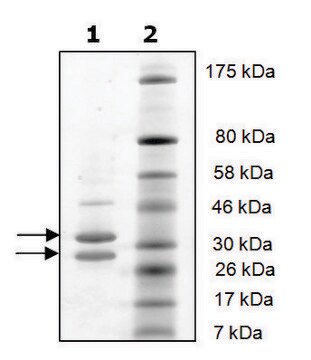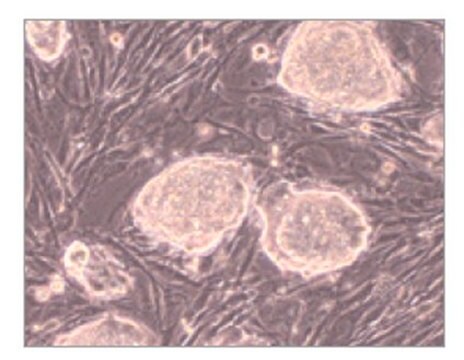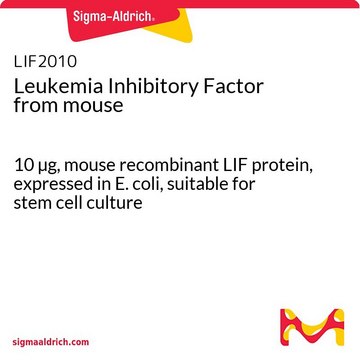MABC594
Anticorps anti-NOTCH 3/N3ECD, clone 1E4
clone 1E4, 1 mg/mL, from mouse
Synonyme(s) :
Neurogenic locus notch homolog protein 3, Notch 3, Notch 3 extracellular truncation, Notch 3 intracellular domain, N3ECD Domain, Ectodermal N3ECD, N3ECD
About This Item
Produits recommandés
Source biologique
mouse
Niveau de qualité
Forme d'anticorps
purified immunoglobulin
Type de produit anticorps
primary antibodies
Clone
1E4, monoclonal
Espèces réactives
human
Concentration
1 mg/mL
Technique(s)
electron microscopy: suitable
immunocytochemistry: suitable
western blot: suitable
Isotype
IgG1κ
Numéro d'accès NCBI
Numéro d'accès UniProt
Conditions d'expédition
wet ice
Modification post-traductionnelle de la cible
unmodified
Informations sur le gène
human ... NOTCH3(4854)
Description générale
Spécificité
Immunogène
Application
Analyse par immunohistochimie : un lot représentatif de cet anticorps a été utilisé pour détecter NOTCH 3 dans des cellules musculaires lisses vasculaires humaines et dans des cellules musculaires lisses de vaisseaux issus de tissu cérébral de personnes atteintes de CADASIL (Jouet, A., et al. (2000) Journal of Clinical Investigation. 105(5):597-605).
Microscopie électronique : un lot représentatif de cet anticorps a été utilisé pour détecter NOTCH 3 dans des cellules musculaires lisses de vaisseaux issus de tissu cérébral de personnes atteintes de CADASIL (Jouet, A., et al. (2000) Journal of Clinical Investigation. 105(5):597-605).
Analyse par immunohistochimie : un lot représentatif de cet anticorps a été utilisé pour détecter NOTCH 3 dans les vaisseaux d'un patient atteint de CADASIL (Rouchox, M.M., et al. (2003) American Journal of Pathology. 162(1):329-342).
Analyse par immunohistochimie : un lot représentatif de cet anticorps a été utilisé pour détecter NOTCH 3 dans des carcinomes colorectaux humains (Rouchox, M.M., et al. (2011) American Journal of Pathology. 224(4):448-60).
Apoptose et cancer
Signalisation du développement
Qualité
Analyse par western blotting : 1 µg/ml de cet anticorps a permis de détecter la protéine NOTCH 3 et la partie ectodermique (N3ECD) dans 10 µg de lysat de cellules MCF-7.
Description de la cible
Cet anticorps détecte à la fois la protéine NOTCH 3 complète (env. 260 kDa) et la partie ectodermique N3ECD (env. 210 kDa).
Forme physique
Stockage et stabilité
Clause de non-responsabilité
Vous ne trouvez pas le bon produit ?
Essayez notre Outil de sélection de produits.
Code de la classe de stockage
12 - Non Combustible Liquids
Classe de danger pour l'eau (WGK)
WGK 1
Point d'éclair (°F)
Not applicable
Point d'éclair (°C)
Not applicable
Certificats d'analyse (COA)
Recherchez un Certificats d'analyse (COA) en saisissant le numéro de lot du produit. Les numéros de lot figurent sur l'étiquette du produit après les mots "Lot" ou "Batch".
Déjà en possession de ce produit ?
Retrouvez la documentation relative aux produits que vous avez récemment achetés dans la Bibliothèque de documents.
Notre équipe de scientifiques dispose d'une expérience dans tous les secteurs de la recherche, notamment en sciences de la vie, science des matériaux, synthèse chimique, chromatographie, analyse et dans de nombreux autres domaines..
Contacter notre Service technique
